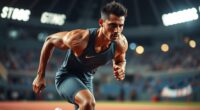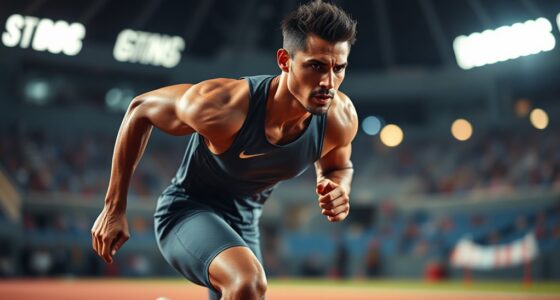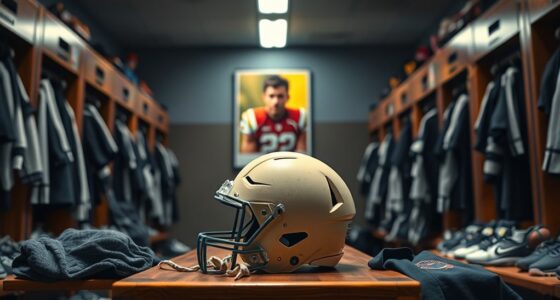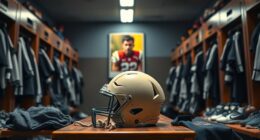Biomechanics labs are quietly transforming Olympic training by giving you detailed insights into your movements and muscle coordination. They help identify inefficiencies and prevent injuries before they happen, ensuring you stay healthy and perform at your best. By customizing equipment and techniques to your unique biomechanics, these labs foster faster skill development and optimize your performance. Keep exploring to discover how these innovations are shaping the future of elite sports success.
Key Takeaways
- Biomechanics labs analyze athletes’ movements to optimize techniques and improve performance efficiency.
- They identify early biomechanical vulnerabilities, reducing injury risks and promoting athlete longevity.
- Labs customize equipment based on detailed biomechanical data, enhancing speed, control, and comfort.
- They enable athletes to visualize and correct movement patterns for faster skill acquisition.
- Continuous biomechanical assessments support tailored training adjustments, maintaining peak performance over time.
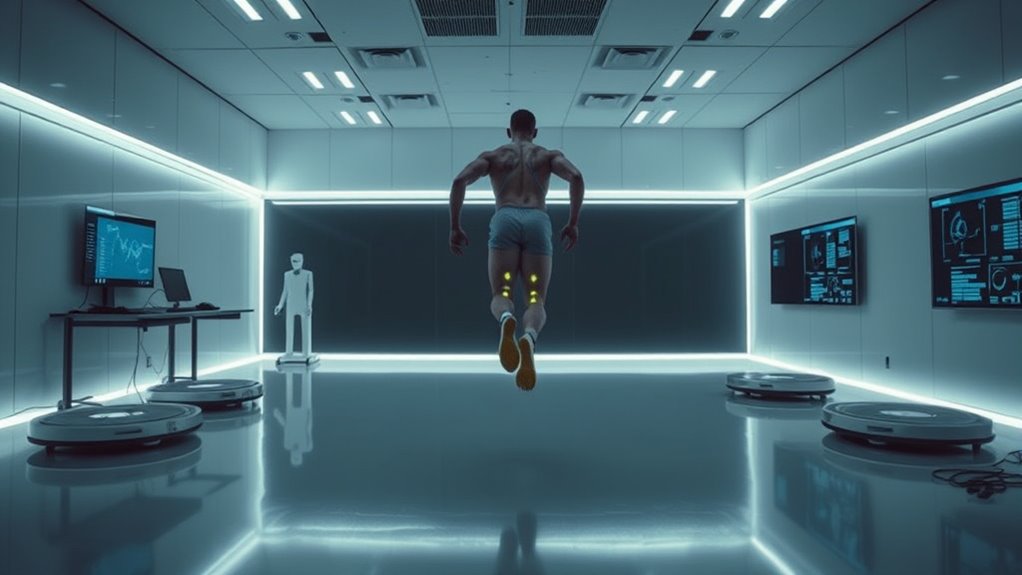
Biomechanics labs play an essential role in advancing Olympic training by providing detailed insights into athletes’ movements and performance. As an athlete aiming for peak results, you might not see these labs behind the scenes, but their impact is profound. They analyze how you move, how your muscles and joints work together, and where inefficiencies or risks may lie. This detailed data allows coaches and sports scientists to fine-tune your techniques, leading to improved performance and minimized injury risks. By understanding the mechanics of your body, they help create personalized training plans that maximize your strengths while addressing weaknesses. This approach is especially critical for athlete injury prevention, as even minor biomechanical issues can escalate into serious injuries if left uncorrected. The labs identify such vulnerabilities early, allowing for targeted interventions that keep you on the field and at your best.
Additionally, incorporating knowledge of natural environments and seasonal variations can optimize training regimens to suit different conditions, further enhancing performance.
Equally important is equipment optimization, which is revolutionized through biomechanics analysis. You might think that choosing the right shoes, poles, or suits is straightforward, but biomechanics labs reveal how subtle modifications can greatly enhance your efficiency. For example, they examine how different shoe soles impact your gait or how the design of a ski pole influences your leverage and control. With this insight, equipment can be tailored precisely to your body and sport, giving you an edge over competitors. This meticulous customization ensures that every piece of gear complements your biomechanics rather than hindering it, leading to faster starts, more powerful jumps, or smoother strides. Coaches and scientists work closely with equipment manufacturers, using lab data to develop innovations that suit your specific needs.
Beyond just improving performance, biomechanics labs foster a deeper understanding of your body’s capabilities. They enable you to visualize your movement patterns and identify areas for improvement that might not be apparent through traditional coaching. This scientific approach accelerates your learning curve, making training more efficient and effective. As you continue to train and compete, ongoing biomechanical assessments ensure your techniques evolve with your development, reducing the likelihood of overuse injuries and ensuring longevity in your sport.
In essence, biomechanics labs quietly but powerfully transform Olympic training by offering a precise, scientific foundation for athlete development. They don’t just help you perform better—they help you stay healthy, optimize your gear, and push the boundaries of what you thought was possible. Your journey to Olympic excellence becomes smarter, safer, and more targeted thanks to these cutting-edge insights.
Frequently Asked Questions
What Specific Equipment Is Used in Biomechanics Labs?
You’ll find biomechanics labs equipped with advanced tools like motion analysis systems, which track your movements in great detail, and force plates that measure the forces exerted during activity. These devices help analyze your technique and performance. By using high-speed cameras, sensors, and software, labs provide precise data that coaches leverage to optimize training and prevent injuries, ultimately enhancing your athletic potential.
How Long Does a Typical Biomechanics Assessment Take?
Like a finely tuned vintage watch, a biomechanics assessment takes about one to two hours. During this time, you’ll go through various tests, analyze your movement, and refine your training protocols. It’s not just about movement; your nutrition and overall performance are considered to optimize results. This thorough process helps athletes like you access peak performance, turning data into powerful insights that improve technique and prevent injuries.
Are Biomechanics Labs Accessible to Amateur Athletes?
You might wonder if biomechanics labs are accessible to amateur athletes. While there are some accessibility challenges, many labs now offer services tailored for amateurs, providing benefits like injury prevention and performance insights. You can find local clinics or sports centers that collaborate with biomechanics experts. These options help you improve your training, making advanced analysis more reachable, even if you’re not competing at an Olympic level.
What Are the Costs Associated With Biomechanics Testing?
When considering biomechanics testing, you should do a thorough cost analysis to understand expenses. Costs can vary based on the complexity of the tests and equipment used. Funding sources like sports organizations, university programs, or sponsorships might help offset costs. Be aware that some labs charge for individual sessions, while others offer package deals. Planning ahead guarantees you maximize benefits without overspending, making advanced biomechanics analysis more accessible.
How Do Biomechanics Labs Measure an Athlete’s Mental Focus?
Think of it as hitting two birds with one stone. Biomechanics labs measure your mental focus through specialized equipment that tracks mental focus metrics, like concentration levels and neural activity. They often integrate neurofeedback technology, allowing you to see real-time brain activity. This helps athletes fine-tune their focus, sharpening their mental edge during training and competition, ultimately boosting performance by turning mental strength into a measurable asset.
Conclusion
As you watch Olympic athletes soar through their routines, remember that biomechanics labs are like secret engines powering their success. Just last year, a sprinter improved her time by fractions thanks to detailed gait analysis—like tuning a finely crafted machine. These labs quietly revolutionize training, turning raw talent into precision performance. So next time you see a record broken, know behind the scenes, science is quietly rewriting the limits of human potential.


